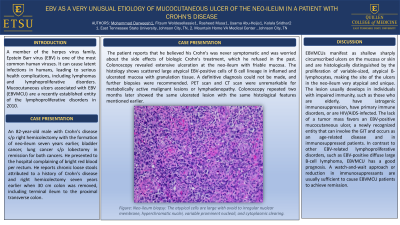Back


Poster Session D - Tuesday Morning
Category: IBD
D0414 - EBV as a Very Unusual Etiology of Mucocutaneous Ulcer of the Neo-Ileum in a Patient With Crohn's Disease
Tuesday, October 25, 2022
10:00 AM – 12:00 PM ET
Location: Crown Ballroom

Has Audio

Mohammad Darweesh, MD
East Tennessee State University
Johnson City, TN
Presenting Author(s)
Mohammad Darweesh, MD1, Fitsum Woldesellassie, MD1, Rasheed Musa, MD1, Usama Abu-Heija, MBBS1, Kolala Sridhar, MD2
1East Tennessee State University, Johnson City, TN; 2Mountain Home VA Medical Center, Johnson City, TN
Introduction: A member of the herpes virus family, Epstein Barr virus (EBV) is one of the most common human viruses. It can cause latent infections in humans, leading to serious health complications, including lymphomas and lymphoproliferative disorders. Mucocutaneous ulcers associated with EBV (EBVMCU) are a recently established entity of the lymphoproliferative disorders in 2010.
Case Description/Methods: An 82-year-old male with Crohn's disease s/p right hemicolectomy with the formation of neo-ileum seven years earlier, bladder cancer, lung cancer s/p lobectomy in remission for both cancers. He presented to the hospital complaining of bright red blood per rectum. He reports chronic loose stools attributed to a history of Crohn's disease and right hemicolectomy seven years earlier when 30 cm colon was removed, including terminal ileum to the proximal transverse colon. The patient reports that he believed his Crohn's was never symptomatic and was worried about the side effects of biologic Crohn's treatment, which he refused in the past. Colonoscopy revealed extensive ulceration at the neo-ileum with friable mucosa. The histology shows scattered large atypical EBV-positive cells of B cell lineage in inflamed and ulcerated mucosa with granulation tissue. A definitive diagnosis could not be made, and further biopsies were recommended. PET scan and CT scan were unremarkable for metabolically active malignant lesions or lymphadenopathy. Colonoscopy repeated two months later showed the same ulcerated lesion with the same histological features mentioned earlier.
Discussion: EBVMCUs manifest as shallow sharply circumscribed ulcers on the mucosa or skin and are histologically distinguished by the proliferation of variable-sized, atypical B-lymphocytes, making the site of the ulcers in the neo-ileum very atypical and unique. The lesion usually develops in individuals with impaired immunity, such as those who are elderly, have iatrogenic immunosuppression, have primary immune disorders, or are HIV/AIDS-infected. The lack of a tumor mass favors an EBV-positive mucocutaneous ulcer, a newly recognized entity that can involve the GIT and occurs as an age-related disease and in immunosuppressed patients. In contrast to other EBV-related lymphoproliferative disorders, such as EBV-positive diffuse large B-cell lymphoma, EBVMCU has a good prognosis. A watch-and-wait approach or reduction in immunosuppressants are usually sufficient to cause EBVMCU patients to achieve remission.

Disclosures:
Mohammad Darweesh, MD1, Fitsum Woldesellassie, MD1, Rasheed Musa, MD1, Usama Abu-Heija, MBBS1, Kolala Sridhar, MD2. D0414 - EBV as a Very Unusual Etiology of Mucocutaneous Ulcer of the Neo-Ileum in a Patient With Crohn's Disease, ACG 2022 Annual Scientific Meeting Abstracts. Charlotte, NC: American College of Gastroenterology.
1East Tennessee State University, Johnson City, TN; 2Mountain Home VA Medical Center, Johnson City, TN
Introduction: A member of the herpes virus family, Epstein Barr virus (EBV) is one of the most common human viruses. It can cause latent infections in humans, leading to serious health complications, including lymphomas and lymphoproliferative disorders. Mucocutaneous ulcers associated with EBV (EBVMCU) are a recently established entity of the lymphoproliferative disorders in 2010.
Case Description/Methods: An 82-year-old male with Crohn's disease s/p right hemicolectomy with the formation of neo-ileum seven years earlier, bladder cancer, lung cancer s/p lobectomy in remission for both cancers. He presented to the hospital complaining of bright red blood per rectum. He reports chronic loose stools attributed to a history of Crohn's disease and right hemicolectomy seven years earlier when 30 cm colon was removed, including terminal ileum to the proximal transverse colon. The patient reports that he believed his Crohn's was never symptomatic and was worried about the side effects of biologic Crohn's treatment, which he refused in the past. Colonoscopy revealed extensive ulceration at the neo-ileum with friable mucosa. The histology shows scattered large atypical EBV-positive cells of B cell lineage in inflamed and ulcerated mucosa with granulation tissue. A definitive diagnosis could not be made, and further biopsies were recommended. PET scan and CT scan were unremarkable for metabolically active malignant lesions or lymphadenopathy. Colonoscopy repeated two months later showed the same ulcerated lesion with the same histological features mentioned earlier.
Discussion: EBVMCUs manifest as shallow sharply circumscribed ulcers on the mucosa or skin and are histologically distinguished by the proliferation of variable-sized, atypical B-lymphocytes, making the site of the ulcers in the neo-ileum very atypical and unique. The lesion usually develops in individuals with impaired immunity, such as those who are elderly, have iatrogenic immunosuppression, have primary immune disorders, or are HIV/AIDS-infected. The lack of a tumor mass favors an EBV-positive mucocutaneous ulcer, a newly recognized entity that can involve the GIT and occurs as an age-related disease and in immunosuppressed patients. In contrast to other EBV-related lymphoproliferative disorders, such as EBV-positive diffuse large B-cell lymphoma, EBVMCU has a good prognosis. A watch-and-wait approach or reduction in immunosuppressants are usually sufficient to cause EBVMCU patients to achieve remission.

Figure: Neo-ileum biopsy: The atypical cells are large with ovoid to irregular nuclear membrane, hyperchromatic nuclei, variable prominent nucleoli, and cytoplasmic clearing.
Disclosures:
Mohammad Darweesh indicated no relevant financial relationships.
Fitsum Woldesellassie indicated no relevant financial relationships.
Rasheed Musa indicated no relevant financial relationships.
Usama Abu-Heija indicated no relevant financial relationships.
Kolala Sridhar indicated no relevant financial relationships.
Mohammad Darweesh, MD1, Fitsum Woldesellassie, MD1, Rasheed Musa, MD1, Usama Abu-Heija, MBBS1, Kolala Sridhar, MD2. D0414 - EBV as a Very Unusual Etiology of Mucocutaneous Ulcer of the Neo-Ileum in a Patient With Crohn's Disease, ACG 2022 Annual Scientific Meeting Abstracts. Charlotte, NC: American College of Gastroenterology.
